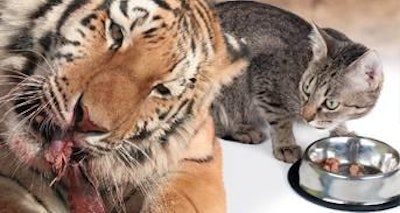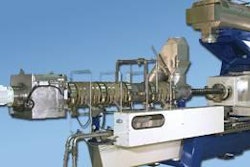
Grain-free and raw pet diets are increasingly appearing on store shelves and being purchased by pet owners seeking natural petfoods. Grain-free diets are defined as petfoods that do not contain cereal grains, such as corn, rice or wheat. Raw diets are composed of raw skeletal muscle along with other ingredients (fiber sources, vitamin and mineral premixes, etc.) to meet the nutrient requirements of dogs and cats.
While their presence in the marketplace is growing, very little research has been conducted to evaluate these diets. However, some recent studies have begun looking into grain-free and raw petfoods for cats.
As obligate carnivores, cats require nutrients found only in animal tissue, yet most commercial cat diets today contain a large amount of carbohydrates. The increased carbohydrates and reduced protein in cat diets have been blamed for causing obesity in cats, but there are very little data to support this claim.
Currently, there is no direct comparison between grain-free and grain-containing diets. Recent research evaluated adult cats during gestation and lactation, kittens and adult cats after spaying when fed grain-free diets with different concentrations of protein and carbohydrate. Kittens fed the grain-free diets had the same body composition as kittens fed commercial diets (Vester et al., 2009a; Lauten et al., 2000).
Furthermore, the adult cats were able to maintain body condition during gestation and lactation and had a similar body composition as adult cats fed commercial diets (Vester et al., 2009b; Lauten et al., 2000). This indicates that grain-free diets do not lead to large differences in body fat content of young cats.
Cats fed grain-free diets ad libitum before and for 24 weeks after spaying gained weight (1.3 kg) following spaying (Vester et al., 2009b). Compared to results from another study in our laboratory at the University of Illinois (Figure 1), cats fed a commercially available grain-containing diet ad libitum for 12 weeks after spaying gained a similar amount of weight (1.3 kg; Belsito et al., 2009).
These studies indicate that grain in the diet is probably not leading to weight gain after spaying; the increase is more likely due to removal of estrogen or testosterone and the interactions with other hormones in the body.
Microbial populations in the large bowel can be influenced by grain-free diets. The grain in typical cat diets provides a fiber source to the animals and leads to carbohydrate fermentation in the colon. While cats are carnivorous and have a short large bowel compared to other species, they still have an active microbial population.
One study used a baseline grain-containing diet, then compared two grain-free diets (Lubbs et al., 2009). This baseline diet had higher fiber content than either of the grain-free diets (8% versus 6% and 2%, respectively). Nonetheless, there was a two-log increase in a potentially pathogenic bacterium ( Clostridium perfringens ) and a one-log decrease in a beneficial bacterial genus ( Bifidobacterium spp. ) when cats were fed the grain-free diet. These differences were likely due to the different amounts and types of fiber included (or not included) in these diets.
Most research on raw diets has focused on bacterial contamination. Many commercial raw diets have been reported to be contaminated with Salmonella spp., E. coli, Salmonella typhimurium and/or Clostridium perfringens (Freeman and Michel, 2001; Weese et al., 2005; Finley et al., 2008). Consumption of these diets can potentially lead to fecal shedding of bacteria. This means owners should take precautions when feeding these diets and disposing of feces.
Though research is limited, three key studies evaluated raw meat diets in domestic cats:
- Cats were fed a high-protein, grain-free, extruded kibble diet, a raw beef diet or a cooked beef diet (Kerr et al., 2008);
- The cats were fed four different raw meat diets based on beef, bison, elk or horse (Kerr et al., 2009); and
- Cats were fed commercially available beef or horse meat-based raw diets (Vester et al., 2010).
All of these diets were grain-free; the beef diets in studies 1 and 3 contained beet pulp as a partially fermentable fiber source, while all other raw diets contained cellulose as a completely unfermentable fiber source. In these studies, the authors measured digestibility: the percentage of each macronutrient the animal was able to absorb and utilize.
Crude protein digestibility of the extruded kibble diet was 80%, while all the raw or cooked meat diets were at least 90% digestible (Figure 2). Fat digestibility was lowest when cats consumed the kibble diet (approximately 92%) and the raw elk meat diet (approximately 87%). All other raw and cooked meat diets had approximately 95% or greater fat digestibility.
Fecal output was reduced by almost 50% when cats were fed raw or cooked meat diets compared to an extruded kibble diet (Kerr et al., 2008). This decrease in fecal output may be advantageous to pet owners.
Fiber source in the raw diets turned out to be important. Raw diets containing cellulose as the fiber source led to excretion of very hard feces as well as to a reduction in Bifidobacterium spp., beneficial bacteria (Vester et al., 2010). When beet pulp was added to the diet instead, fecal scores remained close to ideal values.
We need more research on the health benefits of grain-free and raw diets; all their beneficial effects to date are based on anecdotal evidence, not scientific literature. It is apparent that when formulated correctly, these diets provide adequate nutrition to cats. Feeding them comes down to the preference of pet owners. If they believe the diets make their pets healthier, then there is a place for such products among the numerous nutritional offerings available.















